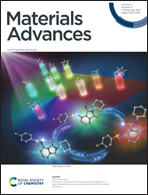Polymerization-tailored polyimides as cathodes for lithium-ion batteries†
Abstract
The sustainable development of lithium-ion batteries (LIBs) urges electrode materials to be low-cost, richly sourced, environmentally benign and to have recycling capability. Polyimides (PIs) as promising alternatives to transition-metal-based cathodes for LIBs have been a hot topic for researchers. However, the relationship between the structure and electrochemical performances of PIs should be further investigated. In this study, we prepared three types of PIs with the same molecular structure but different micro- and crystalline structures from 1,4,5,8-naphthalene-tetracarboxylic acid dianhydride and 1,3,5-tris(4aminophenyl)benzene via different methodologies. When these PI cathodes were assembled into LIBs, it turned out that the as-obtained polyimide framework (PI-COF) with a rich micro/mesoporous structure and high crystallinity demonstrated a higher capacity and better rate performance than that of amorphous PI with weak porosity. Importantly, PI-COF retained 80% of its initial capacity even after 10 000 cycles at 1.5 A g−1, presenting an excellent cycling stability. This showed a great potential to mitigate stability issues that many organic electrodes typically suffer from.



 Please wait while we load your content...
Please wait while we load your content...